Designing the tiny house of your dreams? One of the great things about tiny houses is that you can design them for your needs and preferences, and the door on your tiny home is no different. If you’ve ever wondered about tiny house doors, you are in the right place.
Entryway or front doors set the tone for your entire design. One great way to draw the eye in is with a bright color, like a tiny house with a bright color door. If you are into tiny houses, you’ll soon learn that normal building materials are scaled to big house size, so if you use them on your tiny home, they’ll look weird and out of proportion. That means there will be items in your build that you either have to build from scratch or get customization when finding a solution.
Choosing a door for your tiny house may sound intimidating since size might represent an obstacle Exterior doors come in standard sizes but because your house is tiny, you may need a door that’s smaller than that. Continue reading and find out more about tiny house doors varieties.
Tiny House Doors Varieties FAQ’s
Why buy tiny house doors?
Homes under 600-square feet have distinct needs when it comes to doors. First, the doors must be compact to avoid wasting square footage. Second, the doors must be solid and secure. After all, this is your home, and you want it to be safe.
What options should you consider when shopping for doors for your tiny home?
- Entry Door: It is not uncommon to customize the front door of your tiny home, as these often involve non-standard sizes. Whenever possible, adjust your plans to include standard-size doors to make it much easier to find doors in the styles and designs you want
- Bathroom Door: Naturally, you will want some type of door for your bathroom. Just because you live in a tiny house, interior doors are not a moot issue. Perhaps the logical solution in smaller spaces is found with bathroom sliding doors, often seen in custom tiny homes under 600 feet. Speaking of bathrooms, check out all the different tiny home toilets.
- Privacy Doors: Depending on the layout and purpose of your tiny house, it might be prudent to install privacy doors. Since space is always something to consider, look at thin Japanese-inspired doors or sliding doors that utilize tracks above the doorframe.
- Closets: If you want to hide your clutter and put some doors on your closets, then pocket doors are a viable option. Pocket doors are sliding doors that vanish from view when opened.
How big are Tiny House Doors?
The standard door width for a tiny house is 36 inches. This makes for a really spacious entryway and again, is required by code. One thing to consider is if you have any big items: a couch, shower stall, mattress, and appliances will need to be able to fit through your tiny house door after you’re done building.
Where do doors go on a tiny house?
Front Door Placement for Tiny Homes. It depends, for instance, if you are planning on taking your tiny home on wheels to an RV park, then you’ll want to make sure the front door on your home is installed on the passenger side and not the driver’s side.
Can you build a tiny house for $10000?
Apparently, you can. It is possible to build a tiny house on a shoestring budget. You can even manage it for $10,000 or less. But most tiny houses cost more than that. If you are willing to build your own tiny house, either from the ground up or from a prefabricated model, experts say you may very well be able to do it on a very minimal budget.
What size is a normal living room in a tiny house?
The typical size of a small home seldom exceeds 500 square feet (46 m2). The typical tiny house on wheels is usually less than 8 by 20 ft (2.4 by 6.1 m), with livable space totaling 120 sq ft (11 m2) or less, for ease of towing and to exempt it from the need for a building permit.
How thick are interior walls in a tiny house?
Tiny House walls are about 4.75 inches thick. This includes your interior cladding (1/4″ thick), your wall framing filled with insulation (3.5″ thick), your sheathing (1/2″ thick), and your outer siding (typically 1/2″ +/- depending on your siding).
How wide is the interior of a tiny house?
Typically your tiny house can be up to 8 feet wide inside, so your length will be the main variable that impacts square footage. You’ll notice that a lot of tiny houses tend to be around 200 square feet; that’s because most people don’t want to have to tow a really big trailer.
Is it legal to live in a tiny house on wheels?
In summary, NSW legislation may permit the following: You to have no more than two caravans, campervans or tents if you plan for someone to stay in them for a short-term (up to 48 hours at a time) for no more than 60 days a year.
Tiny House Doors: What to know
Tiny House Door Height: 80 Inches
The standard door height for a tiny house is 80 inches. This size accommodates most people and is also required by building codes in most places.
Tiny House Door Width: 36 Inches
The standard door width for a tiny house is 36 inches. This makes for a really spacious entryway and again, is required by code. One thing to consider is if you have any big items: a couch, shower stall, mattress, and appliances will need to be able to fit through your tiny house door after you’re done building.
Tiny House Door Thickness: 2 Inches
The average tiny house door is about 2 inches thick. This isn’t a hard and fast rule, and code doesn’t come into play here much, but security and standard door casings will push you into a 2 inch-thick door for your tiny house most likely.
Tiny House Door Rough Opening Width: 38 Inches
The rough opening is the part of your wall framing that you complete before you install your door frame, which holds your door.
Tiny House Door Rough Opening Height: 82.5 Inches
The typical height for a rough opening for a tiny house door is 82.5 inches. This accounts for the door frame and that threshold.
Tips to choose tiny house doors
- Design your house to have room for a standard door. Standard-sized doors can be big in a tiny house, taking up space from the interior of the house. A door with a big window, that swings out rather than in, can be a way to incorporate the larger door while adding additional aesthetics.
- Make a standard door fit your tiny frame. Instead of making your house fit the door, make the door fit your house! Shave off a few inches here and there without sacrificing wall space from the house.
- Buy an RV door. RV doors come in smaller than standard sizes, as small as 26 inches wide.
Tiny House Doors Varieties
Preston Collection Customizable Fiberglass Prehung Front Door
Available in zinc or patina along with three hand-stained finish options in chestnut, cherry, and chocolate.
This collection is also standard with hand-stained Pvc jambs that compliment the door stain finish and offer superior performance over wood jambs. The rich mahogany wood grain fiberglass detail provides the look of natural wood with the benefits of fiberglass.
Doors are available in a number of different configurations and options to fit most entryways.
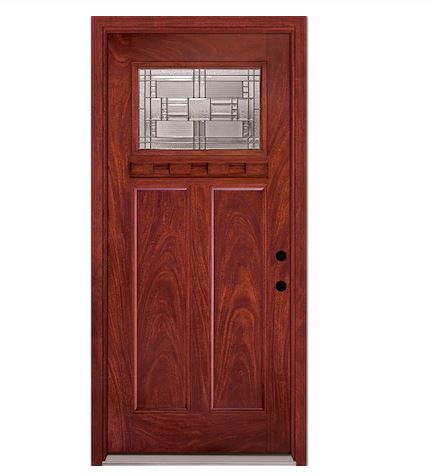
Features:
- Made of fiberglass for durability that weathers the elements
- Boasts an energy-efficient polyurethane foam core
- The design resists rusting, warping, and more
Steves Element Customizable Steel Door Collection
The Steves & Sons Premium Element Steel Door with high definition design provides lasting beauty and security. T
his ENERGY STAR qualified 1-3/4 inch door if prehung is pre-assembled in a fully weather-stripped jamb for easy installation.
The door is assembled with 3 hinges and an adjustable inswing/bumper outswing sill. The door and frame are primed and ready to finish in a color of your choice.
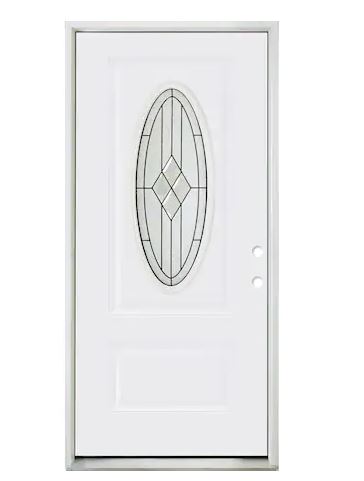
Features:
- Galvanized steel door provides protection from rust
- Double bore with security plate adds strength and security
- The primed surface makes it easy to paint
Legacy Series Pet Door
Keep your pets happy with this traditional direct glazed door. It complements any home’s architecture and is built to perform in any climate, hot or cold, wet or dry.
With less maintenance than a wood or steel door. Not only will this door add beauty to your home, but replacing an old or outdated door with a new one can increase the value of your home.
Complete engineered door construction provides a solid feel. The composite door and frame provide a rot-free system and protect against the effects of the elements.
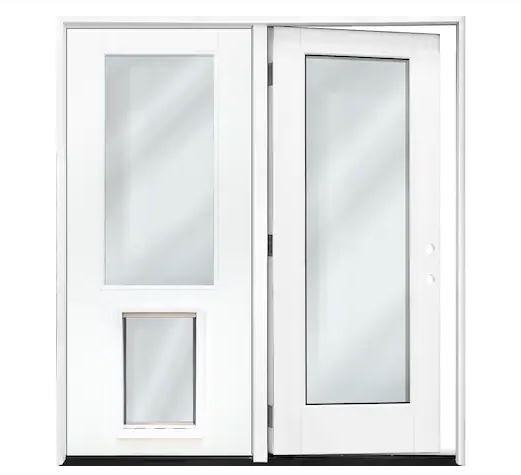
Features:
- Ball-bearing hinges
- Insulated Double pane
- Low-E glass for energy efficiency
Legacy Collection Customizable Fiberglass Door
Not only will this door add beauty to your home, but replacing an old or outdated door with a new one can increase your home’s value.
Ball-bearing hinges provide smooth operation and prevent sagging over time. Insulated double pane Low-E glass for energy efficiency.
High-performance weatherstripping provides an air-tight seal. Adjustable sill allows for installation adjustments to ensure a perfect fit.
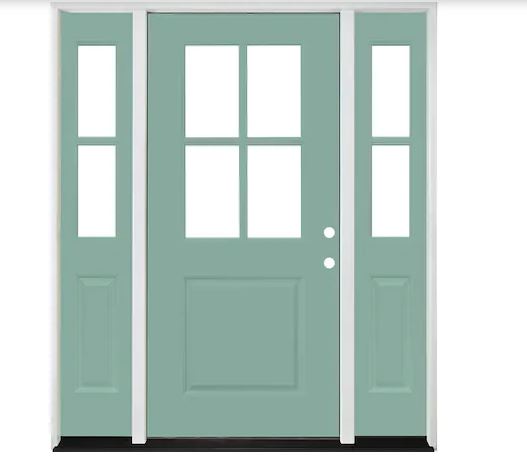
Features:
- Adjustable
- Standard Double Bore
- The door and glass frame can be painted to match
Fiberglass Front Door Bronze Hinge
Complete engineered door construction provides a solid feel. The composite door and frame provide a rot-free system and protect against the effects of the elements.
Ball-bearing hinges provide a smooth operation and prevent sagging over time. Adjustable inswing sill or weather-stripped outswing sill provides an air-tight seal.
Double bore and 3 in. stiles provide added security.
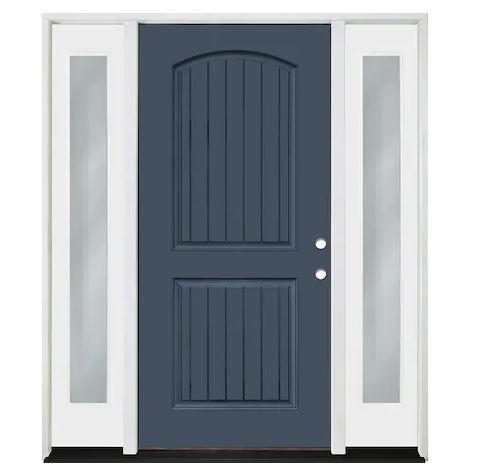
Features:
- Two Sidelites
- Left Hand Inswing
- Fiberglass Front Door


